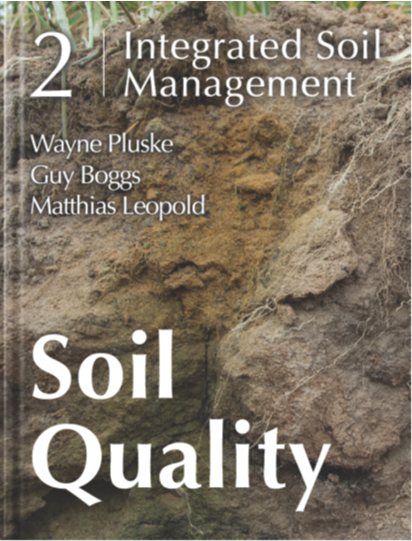What is soil colour?
Colour is an initial guide to soil properties.
Soil colour is an important indicator of internal drainage characteristics and may help distinguish different soil layers (horizons).
Mineral and organic matter determine soil colour. Iron and aluminium oxides form during the breakdown of parent material and remain in the upper part of the profile, contributing to soil colour (these can be leached in very high rainfall areas) – producing red, yellow, grey and bluish-grey colours.
Soil colour can be described in general terms into commonly six colour classes – red, yellow, black, brown, grey and pale. Colour can also be objectively assessed by comparing the colour of a freshly broken surface of moist soil with the standard Munsell Soil Colour Charts.
Soil colour represents soil formation processes over long periods of time and may not always indicate present-day conditions – for example, mottling can indicate the historic fluctuating water tables and waterlogging that the present-day rainfall may not induce. Nevertheless, it does provide a context to the soil, including clues to potential drainage and fertility. A chemical soil analysis is required to confirm the nutrient status of the soil.
What soil colours indicate
Dark colours indicate organic matter
Organic matter imparts a brown colour to the soil. Humus, the final stage in the breakdown of organic matter, as well as charcoal derived from past fires, is black. Therefore, a soil high in organic matter may be brown to black depending on the level of humus. Organic matter build up in white sand can be seen by a greying in the top 20 cm. Dark colours near the soil surface usually indicate high concentrations of organic matter.
A horizons in a healthy state (good organic matter levels) are dark in colour. The absence of dark colours and presence of light blonde, grey or pallid colours at the surface are clear signs of degradation.
Indication of drainage
Soil colour can be modified through soil management and drainage practices, and provides an indicator of the aeration and drainage status of the soil. For example, iron forms a yellow oxide in soil under average air and moisture conditions, changing to red in soils which are better drained or drier, and a grey, green, or bluish-grey and often mottled colour in waterlogged soils where air is lacking.
Soil mottling (spots, streaks of colours contrasting with dominant soil colour – usually bright patches of red, orange or yellow on a yellow, brown or grey background) is caused by changes in the distribution, concentration and state of oxidation of iron compounds. Mottled colours in soil if present at depth and are an indication of fluctuating water tables and waterlogging.
By contrast, soils with good internal drainage and aeration tend to have a rusty-red colour without mottling.
Relative drainage in clay subsoils reflected by colour tends to be red > brown > yellow > dark (black) > grey.
Bleached horizons in a soil profile indicate leaching of iron compounds made more soluble by waterlogged conditions, which may reappear as ‘thin ironpan’ (placic) horizons (20-30 mm thick bands of sand cemented by materials that contain iron and manganese) deeper in the profile. Bleached horizons are a result of nutrient leaching and low nutrient status.
Indication of soil chemistry
White nodules in the soil indicate carbonates. These will also reflect the pH of the soil and free carbonates (free lime) at pH of 8-8.2. This can be tested with a fizz test.
Summary of the main soil colours, associated properties and implications for soil management
| Soil colour | Characteristics | Indicative of |
|---|---|---|
| Black; dark grey | High levels of organic matter, the darker the more organic matter. Restricted in most soils to the topsoil. Some soils consist of 100% organic matter (peat). | Low pH values due to organic acids. High denitrification. In case of peats, permanently waterlogged. |
| Grey-black | Clay rich soils that include high amounts of organic matter deep into the subsoil. Shrink and swell clay minerals efficiently mix the soil profile over the years. | Waterlogging during wet season. Difficult workability when dry. |
| White; pale; bleached | Iron and manganese have been leached out due to conditions that are often acidic and high amounts of rainfall or drainage. A bright white colour can be indicative of crystallised salts. | Low levels of nutrients due to leaching. Reduced water retention. Indicative for saline soils if crystals visible. |
| Red | Red indicates hematite as one form of iron oxide. Indicative of warmer climate and good drainage. This allows oxygen to penetrate deeply into the soil and form iron oxides. Colours tend to be darker red if mixed with some organic matter. | High phosphorus fixation. Good water retention. Good aeration. |
| Yellow to yellow-brown | These soils can have a slightly poorer drainage than red soils. Often forming in a more temperate climate so that iron oxides are less developed. | Moderate phosphorus retention. Low plant available water. Sandy textured yellow soil is easily compacted. |
| Brown | Brown iron oxides are indicative of temperate climatic conditions. Good aeration. | Low to moderate phosphorus fixation. Low to moderate plant available water. |
| Grey; green; dull blue | Such soil colours are indicative of very poor drainage and they are often waterlogged. Low aeration due to to water saturation provides conditions for iron and manganese to form compounds that result in these soil colours. Reducing conditions. | Waterlogging or drainage problems. Anaerobic conditions that increase potential for release of nitrous oxide and methane (greenhouse gasses). Poor soil for plant growth. |
From Soil Quality: 2 Integrated Soil Management (Pluske et al. 2018).
Page references and acknowledgements
Material on this page adapted from:
- Hoyle FC (2007). Soil Health Knowledge Bank.
- Pluske W, Boggs G and Leopold M (2018). Soil Quality: 2 Integrated Soil Management. SoilsWest, Perth, Western Australia. [Access]
Last updated July 2024.














